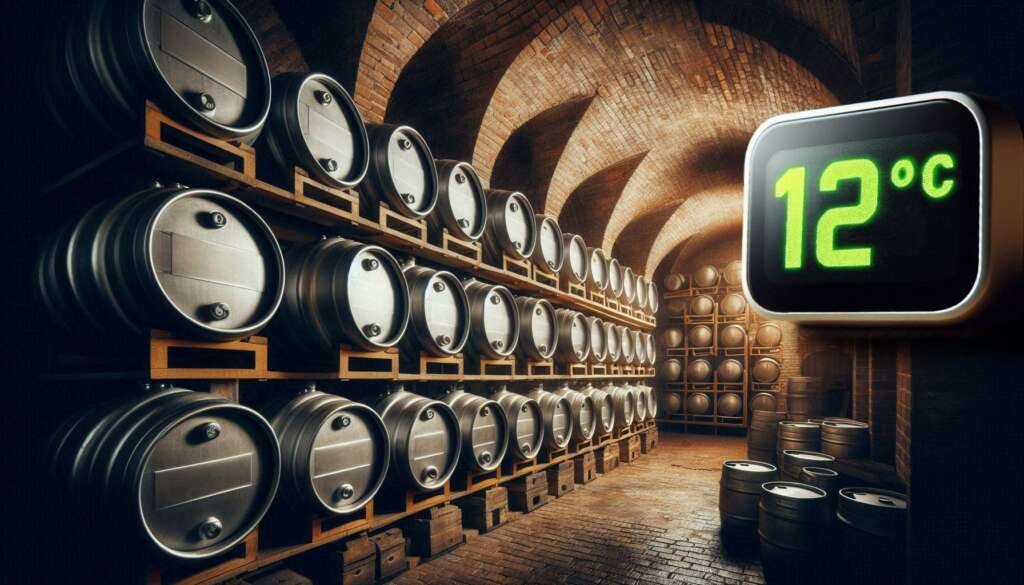The beer cellar is the engine room of any pub, particularly when it comes to draft beers and lagers. One of the most critical aspects of managing a pub cellar is maintaining the right temperature, specifically within the range of 11–13°C (52–55°F). This may seem like a small detail, but even minor temperature fluctuations can have significant effects on the quality, flavor, and lifespan of your beer and lager. To ensure that your drinks are always served at their best, it’s essential to regulate cellar conditions carefully.
In this article, we’ll explore 10 top tips for maintaining the ideal pub cellar temperature and discuss what happens to your beer and lager when the temperature falls outside the optimal range.
1. Understand Why 11–13°C is Ideal for Beer and Lager
2. What Happens When Beer is Too Warm (Above 13°C)
3. What Happens When Beer is Too Cold (Below 11°C)
4. Use a Reliable Thermostat and Monitor Regularly
5. Ensure Proper Insulation of the Cellar
6. Keep the Cellar Door Closed to Maintain Temperature
7. Use Fans for Proper Airflow and Ventilation
8. Store Kegs and Casks Properly to Ensure Even Cooling
9. Calibrate and Maintain Cooling Systems Regularly
10. Train Staff on Cellar Temperature Management
1. Understand Why 11–13°C is Ideal for Beer and Lager
The first step in proper cellar management is understanding why a temperature range of 11–13°C is recommended. This temperature keeps beer, especially cask ale, fresh without causing over-carbonation or flatness. At this temperature, yeast activity is stable, allowing the beer to retain its optimal flavor and aroma.
Lagers, which are typically more carbonated, also benefit from this controlled temperature range. They remain crisp and refreshing without excessive foam or flatness. If the temperature rises or falls beyond this range, the quality of the drink begins to suffer, leading to dissatisfied customers and potential wastage.
2. What Happens When Beer is Too Warm (Above 13°C)
When the cellar temperature exceeds 13°C, both beer and lager can become compromised. Warm temperatures speed up the beer’s aging process, causing it to lose its fresh taste and develop undesirable off-flavors. Cask ales, in particular, are prone to becoming stale and overly sweet when kept too warm. The beer may also start to foam excessively when poured, leading to fobbing (wastage caused by foam).
For lagers, high temperatures can cause the CO2 in the beer to escape, making it taste flat and unappealing. If left in warm conditions for too long, beers can spoil, resulting in a sour or vinegar-like taste.
3. What Happens When Beer is Too Cold (Below 11°C)
On the other hand, a cellar that’s too cold (below 11°C) presents its own problems. Beer stored at too low a temperature can lose its flavor complexity, particularly in cask ales, which require a slightly warmer environment to allow the natural yeast and other ingredients to develop fully. Cold temperatures can dull the beer’s aroma and taste, leading to a flat, lifeless drink.
For lagers, while they may seem to benefit from colder temperatures at first glance, over-chilling can cause excessive carbonation, leading to foamy pours and potential fobbing. A too-cold lager will also lose some of its crispness and can appear cloudy.
4. Use a Reliable Thermostat and Monitor Regularly
To maintain the ideal temperature of 11–13°C, investing in a reliable thermostat is essential. The thermostat should give precise readings and allow you to monitor the temperature closely. Check the temperature at least twice daily to ensure it remains consistent, especially after busy service periods or during weather fluctuations, when cellar temperatures can shift unexpectedly.
Some advanced systems allow you to set alarms for when temperatures rise or fall outside the ideal range, giving you peace of mind and an early warning of any problems.
5. Ensure Proper Insulation of the Cellar
To keep your cellar temperature stable, the room needs to be properly insulated. If the walls, doors, and flooring are not well-insulated, it can become difficult to control the temperature, particularly during hot summer months or cold winters.
Insulate the walls and ceiling of your cellar to prevent heat exchange, and ensure that any doors or windows are sealed tightly when closed. If you notice temperature fluctuations, check for drafts or leaks that could be letting air in or out of the cellar.
6. Keep the Cellar Door Closed to Maintain Temperature
One common mistake pub owners and staff make is leaving the cellar door open, especially during busy periods. This can cause a significant rise in temperature, as warm air from the bar area floods into the cellar. To prevent this, make it a rule to keep the cellar door closed at all times, except during necessary tasks.
It’s also recommended to allow for brief daily ventilation, typically for 10 minutes each day. This helps to circulate fresh air and remove any moisture buildup without compromising the temperature. However, be sure to monitor the temperature closely during and after this period to ensure it returns to the optimal range.
7. Use Fans for Proper Airflow and Ventilation
While keeping the cellar door closed is crucial, it’s also important to maintain good airflow within the cellar to prevent stale air and condensation buildup. Installing low-speed fans can help keep the air moving, ensuring that the temperature is evenly distributed across the room and preventing warm spots or pockets of cool air.
However, ensure that the fans do not direct airflow directly at the kegs, casks, or cooling system, as this can affect temperature consistency.
8. Store Kegs and Casks Properly to Ensure Even Cooling
The way you store your kegs and casks in the cellar can also affect how well they maintain temperature. Always store kegs and casks off the floor on racks or shelving, as the ground tends to be cooler or warmer than the rest of the cellar, depending on insulation.
Organize the kegs and casks with enough space between them to allow for even airflow. Overcrowding the cellar can cause certain areas to become too warm or too cold, leading to uneven cooling and inconsistent beer quality.
9. Calibrate and Maintain Cooling Systems Regularly
A reliable cooling system is essential for keeping your cellar within the 11–13°C range. However, these systems need regular calibration and maintenance to ensure they are working correctly. Set up a schedule to have your cooling equipment checked by a professional to identify any inefficiencies or potential breakdowns.
Over time, cooling units can become less effective due to dust buildup, leaks, or malfunctioning components. Preventive maintenance will help avoid sudden temperature spikes and ensure your beer remains at its best.
10. Train Staff on Cellar Temperature Management
Finally, it’s essential that all staff who handle the cellar are well-trained in maintaining its temperature. Make sure everyone understands the importance of the 11–13°C range and how temperature impacts the quality of beer and lager.
Staff should be trained to regularly check the temperature, keep the cellar door closed, and handle kegs or casks without disturbing the cooling system. They should also be aware of how to handle deliveries properly to prevent sudden changes in temperature from outdoor exposure.
Conclusion
Maintaining the correct cellar temperature of 11–13°C is not just about following guidelines; it’s about ensuring the highest quality beer and lager for your customers. A cellar that’s too warm or too cold can lead to fobbing, spoilage, flat beer, and customer dissatisfaction. By following these ten tips—including keeping the cellar door closed, insulating the room, and regularly monitoring and maintaining cooling systems—you can guarantee a well-functioning cellar that preserves the freshness and flavor of your drinks.
A well-maintained cellar means better-tasting beer, reduced waste, and ultimately, happier customers.




